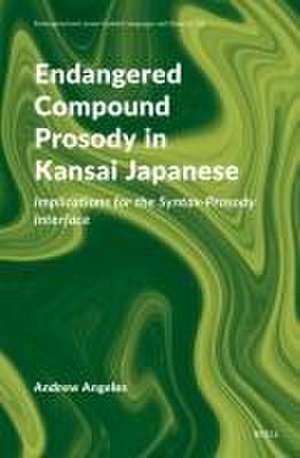Endangered Compound Prosody in Kansai Japanese: Implications for the Syntax-Prosody Interface: Endangered and Lesser-Studied Languages and Dialects, cartea 2
Autor Andrew Angelesen Limba Engleză Hardback – 19 dec 2023
Preț: 602.49 lei
Preț vechi: 734.75 lei
-18% Nou
Puncte Express: 904
Preț estimativ în valută:
115.29€ • 125.62$ • 97.15£
115.29€ • 125.62$ • 97.15£
Carte indisponibilă temporar
Doresc să fiu notificat când acest titlu va fi disponibil:
Se trimite...
Preluare comenzi: 021 569.72.76
Specificații
ISBN-13: 9789004644649
ISBN-10: 9004644644
Pagini: 340
Dimensiuni: 155 x 235 mm
Greutate: 0.58 kg
Editura: Brill
Colecția Brill
Seria Endangered and Lesser-Studied Languages and Dialects
ISBN-10: 9004644644
Pagini: 340
Dimensiuni: 155 x 235 mm
Greutate: 0.58 kg
Editura: Brill
Colecția Brill
Seria Endangered and Lesser-Studied Languages and Dialects
Notă biografică
Andrew Angeles received his PhD in Linguistics from the University of California, Santa Cruz in 2022. His research interests include phonological theory, the syntax-prosody interface, compounding, compound prosody, Japanese dialects, and historical linguistics.
Cuprins
Contents
Preface
Acknowledgments
List of Figures and Tables
1 Introduction
1.1 Introduction
1.2 Overview of the Book
1.3 Background on Japanese Phonology
1.4 The Syntax-Prosody Interface and Match Theory
1.5 Compounds
2 Accent
2.1 Pitch Accent or Tone?
2.2 Accent and Tone Bearing Units
2.3 Characteristics of the Accentual Systems of Tokyo, Kansai, Kagoshima, and Nagasaki Japanese in Simplex Words
2.4 Introduction to Japanese Compounds
2.5 Overview of Tokyo, Kagoshima, Nagasaki, and Kansai Japanese Compound Words
3 The Syntax-Prosody of Japanese Compounds
3.1 The Syntax of Japanese Compounds
3.2 The Syntactic Structure of Japanese Compounds
3.3 Prosodic Structures and Prosodic Categories
3.4 Non-right-headed Compounds
4 Kansai Japanese Compound Accentuation
4.1 Register Inheritance and Accent Loss – Overview and Analysis
4.2 Word Compounds and the Necessity of Junctural Alignment
4.3 Symmetrical Phrasal Compounds
4.4 A Deeper Look at the Word-Phrase Compound
4.5 Implications for a Theory of the Syntax-Prosody Interface
5 Where Do Word-Phrase Compounds Come From?
5.1 The N2 Length Problem and the No Unique Word-Phrase Parse Problem
5.2 Discovering Additional Conditioning Factors on the Word-Phrase Parse
5.3 Novel Fieldwork on the Word-Phrase Parse
6 Conclusion
Appendix 1: List of Constraints
Appendix 2: Full Candidate Sets
Appendix 3: List of Nakai Compounds
Bibliography
Index of Modern Authors
Index of Subjects
Index of Constraints and Constraint Families
Index of Language Names
Preface
Acknowledgments
List of Figures and Tables
1 Introduction
1.1 Introduction
1.2 Overview of the Book
1.3 Background on Japanese Phonology
1.4 The Syntax-Prosody Interface and Match Theory
1.5 Compounds
2 Accent
2.1 Pitch Accent or Tone?
2.2 Accent and Tone Bearing Units
2.3 Characteristics of the Accentual Systems of Tokyo, Kansai, Kagoshima, and Nagasaki Japanese in Simplex Words
2.4 Introduction to Japanese Compounds
2.5 Overview of Tokyo, Kagoshima, Nagasaki, and Kansai Japanese Compound Words
3 The Syntax-Prosody of Japanese Compounds
3.1 The Syntax of Japanese Compounds
3.2 The Syntactic Structure of Japanese Compounds
3.3 Prosodic Structures and Prosodic Categories
3.4 Non-right-headed Compounds
4 Kansai Japanese Compound Accentuation
4.1 Register Inheritance and Accent Loss – Overview and Analysis
4.2 Word Compounds and the Necessity of Junctural Alignment
4.3 Symmetrical Phrasal Compounds
4.4 A Deeper Look at the Word-Phrase Compound
4.5 Implications for a Theory of the Syntax-Prosody Interface
5 Where Do Word-Phrase Compounds Come From?
5.1 The N2 Length Problem and the No Unique Word-Phrase Parse Problem
5.2 Discovering Additional Conditioning Factors on the Word-Phrase Parse
5.3 Novel Fieldwork on the Word-Phrase Parse
6 Conclusion
Appendix 1: List of Constraints
Appendix 2: Full Candidate Sets
Appendix 3: List of Nakai Compounds
Bibliography
Index of Modern Authors
Index of Subjects
Index of Constraints and Constraint Families
Index of Language Names

